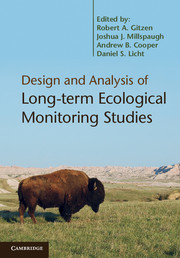Book contents
- Frontmatter
- Contents
- List of contributors
- Foreword: Ecology, management, and monitoring
- Preface
- Acknowledgments
- Abbreviations
- Section I Overview
- Section II Survey design
- 5 Spatial sampling designs for long-term ecological monitoring
- 6 Spatially balanced survey designs for natural resources
- 7 The role of monitoring design in detecting trend in long-term ecological monitoring studies
- 8 Estimating variance components and related parameters when planning long-term monitoring programs
- 9 Variance components estimation for continuous and discrete data, with emphasis on cross-classified sampling designs
- 10 Simulating future uncertainty to guide the selection of survey designs for long-term monitoring
- Section III Data analysis
- Section IV Advanced issues and applications
- Section V Conclusion
- References
- Index
- Plate Section
7 - The role of monitoring design in detecting trend in long-term ecological monitoring studies
Published online by Cambridge University Press: 05 July 2012
- Frontmatter
- Contents
- List of contributors
- Foreword: Ecology, management, and monitoring
- Preface
- Acknowledgments
- Abbreviations
- Section I Overview
- Section II Survey design
- 5 Spatial sampling designs for long-term ecological monitoring
- 6 Spatially balanced survey designs for natural resources
- 7 The role of monitoring design in detecting trend in long-term ecological monitoring studies
- 8 Estimating variance components and related parameters when planning long-term monitoring programs
- 9 Variance components estimation for continuous and discrete data, with emphasis on cross-classified sampling designs
- 10 Simulating future uncertainty to guide the selection of survey designs for long-term monitoring
- Section III Data analysis
- Section IV Advanced issues and applications
- Section V Conclusion
- References
- Index
- Plate Section
Summary
Context
All monitoring is done in some context. The approach and topics considered in this chapter do not apply to all situations, so for clarity I define a context for this chapter. Monitoring programs will almost always be interested in many responses. The example presented in this chapter has about 30 responses, a fairly typical number; some of the discussion will touch on the problems arising from various responses having different sorts of variation and design criteria. However, most of my discussion will focus on analyses of one response at a time, symbolized by Y with suitable subscripts to further identify it.
Monitoring, as used here, refers to studies intended to describe the geographic extent of a resource, general response size, and possible trends therein. Such studies are not sufficiently detailed in either time or space to support ecological modeling of underlying dynamic processes. Resources are always limited. When legal or regulatory requirements specify that inferences must apply to large areas, and budgets are limited, ecological modeling is neither feasible nor appropriate. This chapter is directed toward detection of trend in such situations, but this focus is not intended to imply that monitoring is done exclusively for the purpose of trend detection. In my experience, monitoring has always had many objectives. When trend is detected, a logical next step is to seek to characterize the dynamic process which causes it, assuming time and money are available to do that (see also Chapter 3).
- Type
- Chapter
- Information
- Design and Analysis of Long-term Ecological Monitoring Studies , pp. 151 - 173Publisher: Cambridge University PressPrint publication year: 2012
- 31
- Cited by

